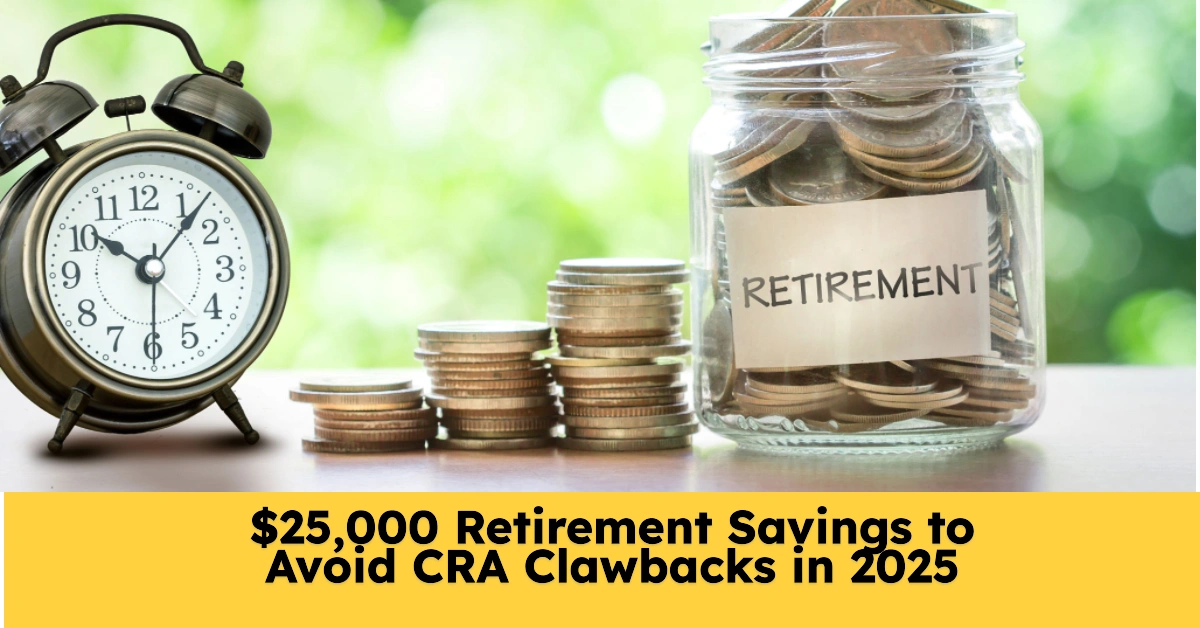When it comes to retirement planning in Canada, saving enough is only half the battle. The other — often overlooked — half is tax planning. Your Canada Pension Plan (CPP), Old Age Security (OAS), and Registered Retirement Savings Plan (RRSP) withdrawals are all taxable. That means the Canada Revenue Agency (CRA) will continue to collect from you in retirement unless you make smart, tax-efficient investment decisions now.
Table of Contents
If you have $25,000 in retirement savings and want to reduce your CRA tax burden — both now and after retirement — where you invest it makes all the difference. Below is a complete guide on how to strategically position that $25,000 in 2025 to create long-term, tax-free income and preserve your benefits like the Guaranteed Income Supplement (GIS).
When to Use RRSP for Retirement Savings
RRSPs are powerful tax-deferred tools — but only when used correctly. The key benefit is the immediate tax deduction you receive when you contribute. This is most valuable when your current income is high enough that the deduction pushes you into a lower tax bracket.
You should consider investing your retirement savings into an RRSP if:
- Your annual taxable income is above $50,000–60,000
- You need to lower your taxable income this year
- You plan to withdraw in retirement when your tax bracket is significantly lower
Otherwise, an RRSP can backfire in retirement. Every dollar withdrawn is considered taxable income, which could trigger GIS clawbacks or push you into a higher tax bracket, especially if you’re already maxing out your CPP and OAS benefits.
How I’d Invest $20,000 in Canadian Renewable Energy Stocks for Long-Term Wealth and Passive Income
High Dividend Yields: A Smart Way to Boost Your Income
Top Canadian Gold Stocks to Buy Now
Manulife (TSX) and CIBC (TSX) Are Up 65% and 60%, Respectively, in the Past 12 Months
Top 3 Undervalued Stocks Under $500 You Should Consider Buying Today
Why TFSA is Better for Minimizing CRA Tax Impact
A Tax-Free Savings Account (TFSA) allows you to contribute after-tax dollars and withdraw your investments (and gains) completely tax-free — no matter your income level. In 2025, the cumulative TFSA contribution room is $102,000 for those who were 18+ in 2009 and have never contributed.
TFSA is ideal for:
- Those already contributing the maximum to CPP
- Individuals who want to avoid GIS clawbacks
- Retirees or near-retirees who want tax-free cash flow
TFSA withdrawals do not affect your taxable income, which means your CPP, OAS, and GIS are preserved — and you pay zero tax on the growth of your money.
Where I’d Invest $25,000 in 2025: TFSA + Two High-Quality Stocks
If I had $25,000 in retirement savings in 2025 and wanted to minimize CRA tax impact, I’d place the entire amount inside my TFSA and invest in two specific stocks: one for long-term capital growth, and one for passive dividend income.
1. Topicus.com (TSXV:TOI) – High-Growth, Tax-Free Capital Gains
- Type: Growth Stock
- Investment: $15,000
- Reason: Topicus is a European-based software company spun off from Constellation Software. It focuses on acquiring small, niche software businesses that generate consistent cash flow.
Why Topicus?
- It operates in the mission-critical software space — these are companies people can’t stop using, even in recessions.
- Since its TSXV debut in February 2021, Topicus has grown by over 150%, turning a $10,000 investment into $24,327 in just four years.
- Investing $15,000 today and holding for 10–15 years could result in a multi-bagger return — all tax-free inside your TFSA.
2. Manulife Financial (TSX:MFC) – Dividend Growth & DRIP Advantage
- Type: Dividend Stock
- Investment: $10,000
- Reason: Manulife is one of Canada’s largest insurance and financial services companies, known for its steady dividend growth and strong fundamentals.
Why Manulife?
- It has grown dividends at a 10.7% average annual rate over the past decade.
- Offers a Dividend Reinvestment Plan (DRIP), allowing you to buy more shares automatically and compound your returns over time.
- Current yield: ~4.9%, which equates to $490/year tax-free income inside TFSA.
Although Manulife is trading near its 52-week high, buying gradually — especially on market dips — can help you lock in a higher yield and enjoy long-term compounding growth.
What This $25,000 Retirement Strategy Looks Like
| Stock | Investment | Focus | Annual Return Potential | Tax Treatment |
|---|---|---|---|---|
| Topicus.com (TOI) | $15,000 | Growth | 12–20% annualized (long term) | Tax-free capital gains in TFSA |
| Manulife (MFC) | $10,000 | Dividends | ~$490/year dividend income (4.9%) | Tax-free income in TFSA |
By holding these investments inside a TFSA, all growth and income remain untouched by CRA, and withdrawals don’t count as income — meaning your GIS and OAS remain intact.
Final Thoughts: Smart Retirement Planning Means Smart Tax Planning
Where you invest your money matters just as much as how much you invest. By using your TFSA wisely and choosing a mix of growth and dividend stocks, you can ensure your retirement savings grow tax-free and create a reliable, low-risk stream of income — all while minimizing CRA tax impact.
If you’re already contributing the maximum to CPP, positioning your retirement savings into a TFSA with tax-efficient investments is the smartest move in 2025.
